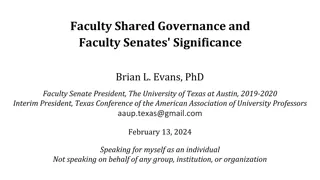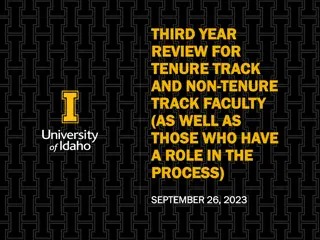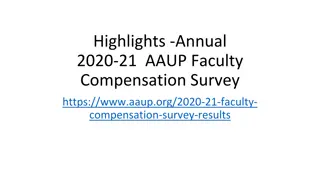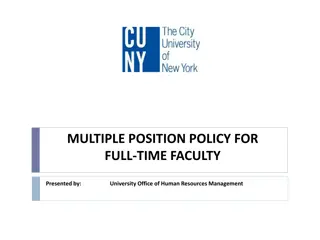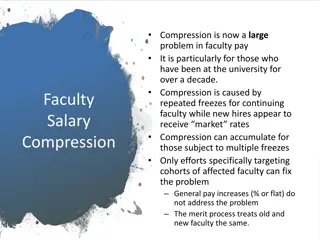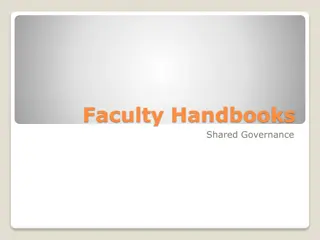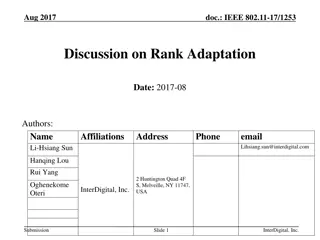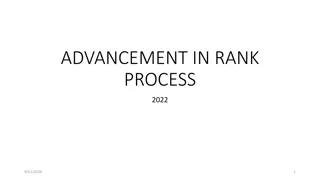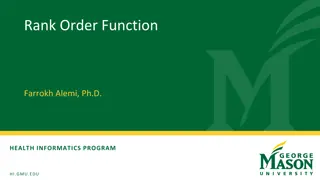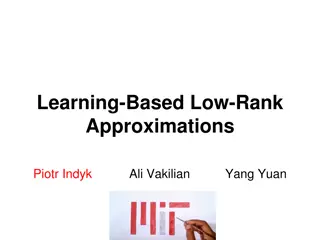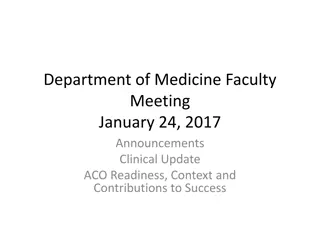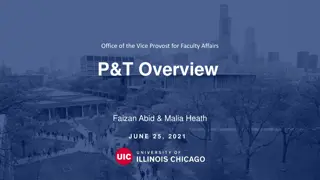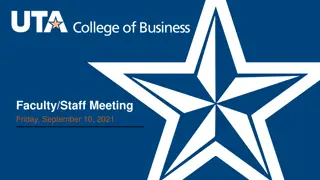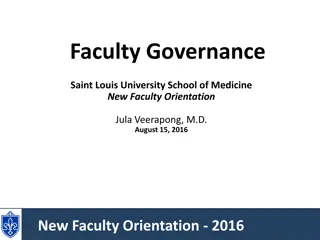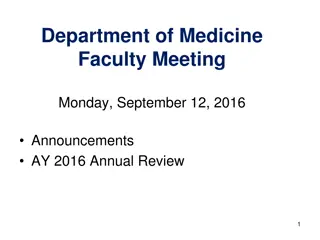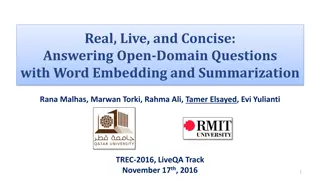Improving Faculty Rank System at a Growing University
The existing rank system at the University lacks clarity and equity, hindering faculty promotion to the professor rank. Issues such as unclear promotion criteria, time to promotion, and lack of recognition for faculty contributions need addressing. Proposed changes include aligning tracks and ranks, setting clear criteria for promotion, and recognizing diverse faculty contributions.
Download Presentation

Please find below an Image/Link to download the presentation.
The content on the website is provided AS IS for your information and personal use only. It may not be sold, licensed, or shared on other websites without obtaining consent from the author. Download presentation by click this link. If you encounter any issues during the download, it is possible that the publisher has removed the file from their server.
E N D
Presentation Transcript
Proposed Expanded Appointment & Proposed Expanded Appointment & Rank System Rank System Winter 2023 1
The Problem to Be Solved Not all faculty at the University have a clear path to promotion to the Professor rank. FP104 neglects to articulate a comprehensive and equitable rank system that recognizes and provides opportunities for rank advancement to all faculty. As a growing University, FP104 requires flexibility to recognize the talents and skills of all its full- time faculty and their unique contributions to the University and its students. Current FP104 doesn t provide a path to promotion for faculty currently in the instructor rank. Criteria for promotion in current FP104 is unclear and doesn t relate to faculty performance evaluation criteria. Faculty track and rank are not fully aligned to the work expectations. Faculty who are terminally credentialed are not acknowledged for their additional expertise An appropriately credentialed professoriate is a commonly understood convention and practice among accreditors. Faculty rank promotion is a system designed to reward and distinguish faculty for individual achievement such as credential attainment.
The Problem to Be Solved Time to promotion is unclear. FP104 has unclear language about time in rank expectations resulting in confusion for faculty. University practice lacks mechanism(s) to prepare and communicate to faculty their readiness for promotion. Recognition for promotion doesn t incentivize participation. Faculty have expressed that the amount of effort to prepare a dossier for promotion isn t worth the salary increase. Faculty have expressed that the higher ranks don t carry benefits that reward faculty for achieving those ranks. Letter of Appointment (LOA) and multi-year appointment processes lack meaning for non- tenure faculty. The University s annual LOA process might be eroding morale since it symbolically and literally reminds faculty of their at-will nature on a yearly basis. The multi-year appointment model doesn t achieve the University s goal: to demonstrate a shared commitment of employment between the faculty member and the University.
Changes to Address Problems Not all faculty at the University have a clear path to promotion to the Professor rank. FP104 has three tracks for faculty appointment: Professional Practice, Teaching, and Tenure. FP104 establishes the three tracks as equitable tracks: 27 shs/45 qhs as base for all the tracks with the same salary bands for the equivalent ranks across the tracks that establish equitable salary for the ranks regardless of track. FP104 articulates different expectations for faculty contributions for the three tracks - but the different expectations do not imply greater value for one track versus other tracks. Professional Practice - expected to contribute to Teaching Excellence, Service, and have an opportunity to contribute to Thought Leadership (as an expert practitioner). Teaching - expected to contribute in two domains: Teaching Excellence, Service, and have an opportunity to contribute to Thought Leadership (as an expert in Teaching and Learning). Tenure - expected to contribute in three domains: Teaching Excellence, Service, and Thought Leadership (as a scholar). FP104 articulates a path to the Professor rank for faculty whose focus is Teaching Excellence that doesn t require a terminal degree but evidence of Teaching Excellence. FP104 articulates clear criteria for each domain to guide faculty contributions and will be used to evaluate faculty performance and promotion. Track and ranks are aligned to better align and communicate faculty work expectations.
Changes to Address Problems Faculty who are terminally credentialed are not acknowledged for their additional expertise FP104 articulates that faculty in the Professional Practice and Tenure tracks need to hold a terminal degree to achieve the Associate Professor of Practice/Associate Professor and Professor of Practice/Professor ranks. FP104 articulates that faculty who earn a terminal degree while employed at NLU will receive $1000 salary increase. Time to promotion is unclear. FP104 establishes exact number of years in rank before a faculty is eligible for promotion. Professional Practice Track - Years in Rank Before Eligible for Next Rank Teaching Track - Years in Rank Before Eligible for Next Rank Tenure Track - Years in Rank Before Eligible for Next Rank Instructor of Practice - 3 years Teaching Instructor - 3 years Assistant Professor and Tenure Review- 5 years Assistant Professor of Practice - 4 years Assistant Teaching Professor - 4 years Associate Professor - 5 years Associate Professor of Practice - 5 years Associate Teaching Professor - 5 years
The Problem to Be Solved Recognition for promotion doesn t incentivize participation. FP104 revision increases the salary increase for achieving rank promotion. (Promotion increases are contingent on the financial standing of the University and could be delayed.) Assistant Professor of Practice/Teaching Assistant Professor/Assistant Professor $2000 (none previously established) Associate Professor of Practice/Associate Teaching Professor/Associate Professor $5000 (represents a $2500 increase) Professor of Practice/Teaching Professor/Professor $7000 (represents a $2000 increase) FP104 amends the salary increase for Tenure track faculty achieving tenure and earning promotion to Associate Professor. All faculty will receive $5000 for achieving the equivalent Associate rank. Achieving tenure will no longer receive a salary increase. FP103 establishes a new FPE cadence that s aligned to ranks. Instructor of Practice/Teaching Instructor Annually Assistant Professor of Practice/Teaching Assistant Professor/Assistant Professor Annually Associate Professor of Practice/Associate Teaching Professor/Associate Professor Biennially Professor of Practice/Teaching Professor/Professor Triennially
The Problem to Be Solved Letter of Appointment (LOA) and multi-year appointment processes lack meaning for non- tenure faculty. Multi-year appointment model will change to a 1-3-5 model to better reflect the University s commitment to its faculty. Faculty of all ranks in the Professional Practice and Teaching track will be eligible for 1 or 3 year appointments at any time, including at the time of hire. Faculty holding Associate Professor of Practice/Associate Teaching Professor or Professor of Practice/Teaching Professor will be eligible for 5 year appointments. LOA process will be revised to align with the multi-year appointment cadence. Example: If a faculty member is on a 3 year appointment, the faculty will receive an LOA to start the 3 year appointment and will not receive another LOA until they renew their appointment at the conclusion of 3 years.
Implementation Principles for Implementation of FP104 Changes No harm Any change will not harm a person s ability to achieve promotion, tenure, or a multi-year appointment. Collaborative Colleges or Units will conduct a collaborative process for assigning faculty to tracks to ensure individual situations are considered. Shared Governance IPTRC and Academic Cabinet will collaborate on the implementation plan. Inclusion Faculty will be able to provide their thoughts and concerns about the implementation plan, which will be considered by IPTRC and Academic Cabinet High-level Timeline July 1, 2023 Release of Implementation Plan February 28, 2024 Deadline for non-tenure faculty to be appointed to a track Tenure track faculty will remain on the tenure track March 1 June 30 FPE cycle, adhering to revised FP103 and FP104 changes Faculty and Deans determine multi-year appointments of non-tenure faculty July 1, 2024 LOAs articulating track appointment and multi-year appointment are issued to all, current full-time faculty *An updated FP104 will necessitate revisions to policies, such as: FP102, FP107, FP114, FP115
Proposed Expanded NLU Faculty Rank System Proposed Teaching Track Professional Practice Track Tenure Track Teaching Instructor Minimum credential(s) necessary to teach in faculty s home program Instructor of Practice Minimum credential(s) necessary to teach in faculty s home program Assistant Professor Earned Master s degree. Demonstrates the potential to contribute as a scholar to the University research strength areas. Assistant Professor of Practice Earned Master s Degree Documented teaching experience Demonstrates potential to contribute as a thought leader to the faculty's field of practice. Assistant Teaching Professor Minimum credential(s) necessary to teach in faculty s home program Documented teaching experience Associate Professor Earned terminal degree in teaching or scholarship field. Record of accomplishment in teaching excellence, scholarship in the University s research strength areas, and service outcomes at a HEI. Associate Teaching Professor Minimum credential(s) necessary to teach in faculty s home program Significant record of accomplishment in teaching excellence and service at a HEI. Associate Professor of Practice Earned terminal degree in teaching field Record of accomplishment in teaching excellence, thought leadership in their field of practice, and service outcomes at HEI. Professor Earned terminal degree in teaching or scholarship field. Significant long-term and consistent record of accomplishment in teaching excellence, nationally recognized scholarship in the University s research strength areas, and long-term and service outcomes at a HEI. Teaching Professor Minimum credential(s) necessary to teach in faculty s home program Significant long-term and consistent record of teaching accomplishment and service to a HEI. Professor of Practice Earned terminal degree in teaching field Significant long-term and consistent record of accomplishment in teaching excellence, nationally recognized thought leadership in their field of practice, and service outcomes at a HEI.


